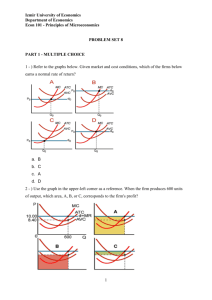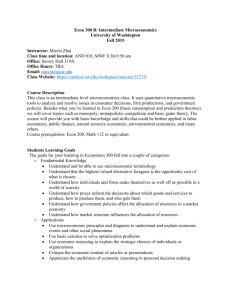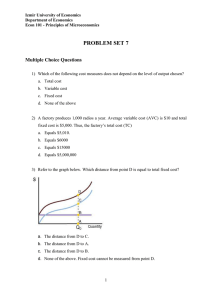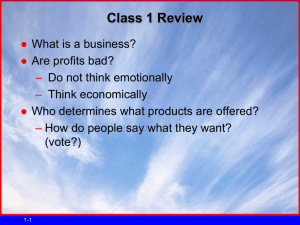Problem Set 8 - Answers
advertisement
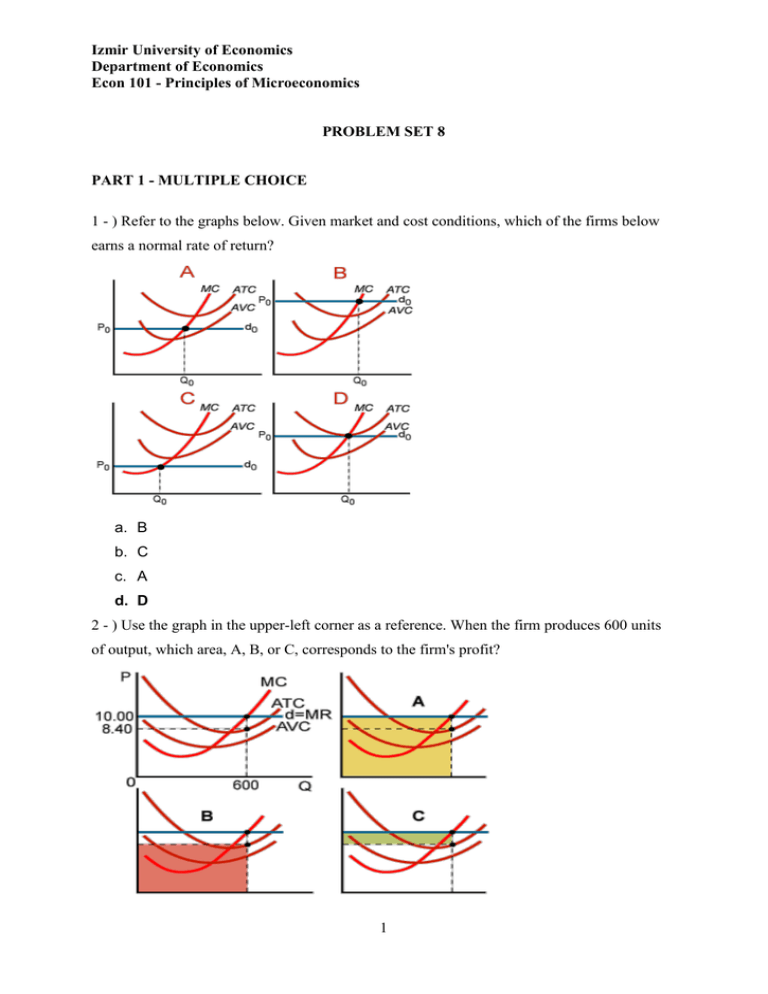
Izmir University of Economics Department of Economics Econ 101 - Principles of Microeconomics PROBLEM SET 8 PART 1 - MULTIPLE CHOICE 1 - ) Refer to the graphs below. Given market and cost conditions, which of the firms below earns a normal rate of return? a. B b. C c. A d. D 2 - ) Use the graph in the upper-left corner as a reference. When the firm produces 600 units of output, which area, A, B, or C, corresponds to the firm's profit? 1 Izmir University of Economics Department of Economics Econ 101 - Principles of Microeconomics a. A b. C c. B d. None of the above. 3 - ) In the long-run, profits equal zero in a competitive market because of a. increasing returns to scale b. identical products being produced by all firms c. the availability of information d. free entry and exit 4 - ) If firms in a P.C. industry are making economic profits, in the long run profits will be reduced when: a. new firms enter leading to reduced market demand. b. new firms enter leading to increased market supply. c. some firms exit leading to an increase in demand for remaining firms. d. some firms exit leading to a decrease in supply by remaining firms. 5 - ) Refer to the graph below. Which of the following statements is/are correct? a. At the price level P0, the firm is indifferent between producing Q0 units or shutting down. b. The price level P0 is sufficient to cover all of the firm's variable costs if it chooses to produce, but none of the fixed cost. c. If the price level falls below P0, the firm will shut down. d. If the price level rises above P0, the firm will choose to produce even though it will suffer a loss. e. All of the above. 2 Izmir University of Economics Department of Economics Econ 101 - Principles of Microeconomics 6 - ) Refer to the graph below. The graph describes: a. Three scales that the firm can choose in either the short run or the long run. b. Three scales, each of which defines a different long run. c. Three scales of operation within the same short run. d. Three scales, each of which defines a different short run. 7 - ) Every point on a U-shaped long-run average cost curve represents a. the minimum cost at which the associated output level can be produced when the scale of plant can be changed. b. the minimum point of the associated short-run average cost curve. c. the minimum cost at which the associated output level can be produced when the scale of plant cannot be changed. d. Both A and B 8 - ) The short-run supply curve of a competitive firm is the portion of a. the average variable cost curve that lies above its marginal cost curve. b. its marginal cost curve that lies above its average variable cost curve. c. its marginal cost curve that lies above its average total cost curve. d. its average total cost curve that lies above its marginal cost curve. 3 Izmir University of Economics Department of Economics Econ 101 - Principles of Microeconomics 9 - ) Which of the following is the set of conditions necessary for long-run equilibrium for a perfectly competitive firm? a. P = SRMC < SRAC = LRAC b. P > SRMC = SRAC = LRAC c. P = SRMC = SRAC > LRAC d. P = SRMC = SRAC = LRAC Refer to the information provided in Figure 1 below to answer the questions that follow. 10 - ) Refer to Figure 1. Industry demand is initially D1 and industry supply is initially S1 in this increasing cost industry. If demand increases to D2, then in the long run the industry will a. stay at Point B. b. move to Point C. c. move to Point E. d. move to Point F. 11 - ) Refer to Figure 1. The type of industry depicted in this situation is a. an increasing-cost industry. b. a decreasing-cost industry. c. a constant-cost industry. d. impossible to determine from this information. 4 Izmir University of Economics Department of Economics Econ 101 - Principles of Microeconomics PART II – ESSAY QUESTIONS 1 - ) In the below figure, panel (a) shows the equilibrium in a competitive market and panel (b) shows the cost structure of a representative competitive firm A. a. What is the profit-maximizing output level for firm A? 10 b. At the output level you got in a., calculate the following numbers: Total revenue (TR) = 200 , Total cost (TC) = 150 , TVC = 100, TFC = 50, Total economic profit = 50 c. What is the shutdown price? 8 What is the break-even price? 12 d. Should this firm operate or shut down in the short-run and long-run? Operate in both of them. 5
